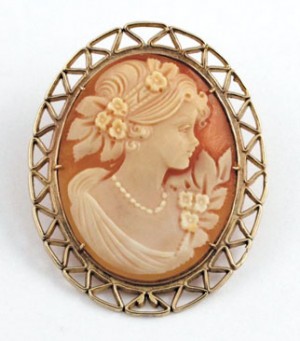Jewelry goes in and out of vogue. The geometric rhinestone creations of the 1930s, the teardrop earrings of the 1950s, and 1970s love beads have all come and gone. But one piece of jewelry has endured for centuries. Valued by many as a family heirloom and elevated by some to the level of a miniature piece of art, today’s collectors are willing to pay top dollar for fine cameos.
The cameo, although traceable to the ancient Greco-Roman Empires of the first century BC, came into popularity in modern culture during the Victorian era. Worn by both men and women, they were highly prized for their high relief designs and magnificent colors.
The majority of the cameos which surface here in central Indiana are from 1890 forward and feature the female profile. Occasionally a ring will surface with a mythological motif, nature scene, or the face of a historical figure. Rings with these motifs are from the late 1700s through the early part of the 1880s and are a rare find.
Cameos fall into two categories: molded cameos made of plastic and hand-carved cameos made of materials found in nature. It is the hand-carved cameo that is of value. Identification is tricky to the untrained eye, but the key here is to watch for quality both in the materials used and in the execution of the piece. A carved cameo will have very precise, high relief line and a thin concave back. Quality hand-carved cameos will usually be mounted in sterling silver, gold plate or karat gold and will be clearly marked. Costume or molded cameos will be glued into heavy pot metal frames.
To assist you in knowing a good cameo when you find one, it is important to know the materials to watch for. Most high quality hand-carved examples will be made from one of the following:
• Agate Cameos — Very popular with high-end collectors, these pieces will have a two-tone swirl pattern that is very apparent from a side view. These will be shiny.
• Blue Agate Cameos — Carved from Brazilian agate, they will range in color from a milky white-gray to a rich dark gray. The top layer of the carving will always be the lightest, graduating down to a darker tone on the base.
• Stone Cameos — Made in Italy and other European countries, they will command top dollar due to the difficulty in the carving process. They can be identified by a slight gap where the two layers meet.
• Shell or Coral Cameos — Most of the shell used comes from the Bahamas, Madagascar, or the West Indies. Because the shells used are each different, fine shell cameos be one of a kind. They will be well colored horizontally with the lightest colors again on the top. A shell cameo will appear semi-transparent when held up to the light.
Proper care and cleaning of your antique cameos will keep them looking beautiful for many years. But note, when you introduce an old piece of jewelry to modern chemicals you run the risk of ruining your valued heirloom.
Professional cleaning is always the best choice, but your piece may be greatly helped by a very soft (baby) toothbrush and warm water. Remember not to scrub it till it shines as some tarnish from aging will actually lend to it’s “antique” appearance. Until next time . . . . Linda
Irvington resident Linda Kennett is a professional liquidation consultant specializing in down-sizing for seniors and the liquidation of estates and may be reached at 317-258-7835 or lkennett@indy.r.com



